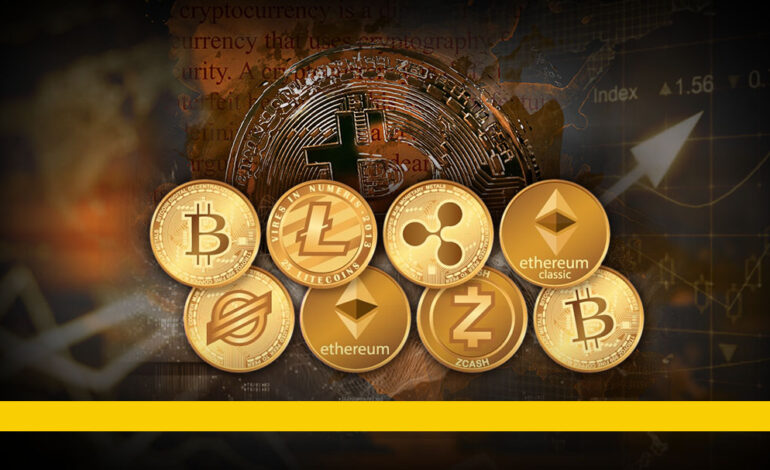A Glance at Prominent Cryptocurrencies

The AIDEM had begun this series in order to disseminate a larger understanding of the complex Bitcoin world. We had titled this series “As Bitcoin Legends Tumble, A Broader Look at the Sector.” The context for giving this title is evident. The month of November had seen a number of revelations about illegal practices in the Bitcoin world and many big players in the sector had come under a shadow. Some top Bitcoin players were even sentenced by the judiciary, including in the US. The first part titled “The Bitcoin Revolution, A Layman’s Perspective” had taken a historical overview of the sector. Read on to know more about cryptocurrencies in this second part of the series.
Satoshi Nakamoto’s paper Bitcoin: A Peer-to-Peer Electronic Cash System [1] started the revolution of cryptocurrencies in general and Bitcoin in particular. The AIDEM article “The Bitcoin Revolution, A Layman’s Perspective” [2] gave a brief introduction to Bitcoin. The same article also touched on the market capitalization of the top ten cryptocurrencies. In this article, we will try to unpack the details of the top three cryptocurrencies.
Bitcoin
There is not enough transparency on how the world’s fiat currencies are minted and the amount of currency in circulation. But cryptocurrencies are different. We have seen that Bitcoin is minted by the mining nodes in the Bitcoin network. How did the first Bitcoin come into existence? The Bitcoin transactions floated on the Bitcoin network get organized into blocks. The first block is called the genesis block [3]. A miner, who runs the mining nodes, adds a new block to the blockchain and receives a certain amount of newly minted Bitcoins for that effort. These Bitcoins are called ‘block rewards’ given to the miner.
The block reward was fifty Bitcoins per block when the genesis block was created. After every 210,000 blocks of Bitcoin transactions, the block reward will become half until all 21 million Bitcoins are mined. The method of halving the block reward is coded into the Bitcoin protocol. This article from Forbes, Bitcoin Halving 2024 – What You Need To Know [4], explains the schedule of Bitcoin reward halving with dates right from the genesis block in detail.
The miners also receive transaction fees on top of the block reward. When I am sending Bitcoins to a third party, I can include a certain amount of Bitcoins or a very small fraction of them as a transaction fee to the miner. This ensures that my transaction gets added to a block faster, as the miner now has a special interest in including this transaction in the next block. In summary, the miner’s revenue includes the block reward and the total of the transaction fees included in a given block. As time progresses, the block reward is dwindling due to the block reward halving phenomenon.

The Bitcoin network keeps adding blocks of Bitcoin transactions without any major hiccups since its inception. To add a new block to the blockchain, the miners have to do lots of computationally intensive calculations called proof of work [5]. It requires sophisticated computing machinery. You need a lot of cheap electricity, powerful computer processors, and expertise.
Many environmentalists have pointed out the environmental damage that cryptocurrency mining and trading cause due to their proclivity to consume a lot of electricity. In addition, there are political concerns as well. China’s ban on Bitcoin mining and trading [6] is a case in point. Other nations are also banning cryptocurrencies altogether or controlling trading to prevent wealth from going out of their countries without checks. All of these corrective actions are also taken to protect their fiat currencies.
Stablecoins, newer forms of cryptocurrencies
Based on the rock-solid foundation laid by blockchain technology, many researchers have begun considering alternative cryptocurrencies to solve various problems. Since 2010, we have seen a flurry of new cryptocurrencies coming into the market, and as a result, cryptocurrency exchanges have started trading other cryptocurrencies as well.
Cryptocurrencies, such as Bitcoin, have experienced significant value fluctuations since their inception. This brings lots of challenges to many investors and users. When it comes to investing, many people are hesitant to take significant risks. To address this issue, new types of cryptocurrencies called stablecoins were created. Typically, these stablecoins are pegged to a fiat currency, such as the US dollar. These stablecoins are minted based on the amount of fiat currency received. In a very superficial sense, these stable coin operators work like banks using blockchain technology. They take deposits in the appropriate fiat currency, and as proof of deposit, they issue stablecoins.

If you take a simple credit card transaction, there are so many parties involved in the whole process of completing it. Consumers receive credit cards from issuing banks, and they use these cards at stores or for online transactions. The merchants use the services of their acquiring banks, who process the payments through the appropriate payment card networks such as VISA and Mastercard. Finally, the card issuing banks pay the merchants. It is an extremely complex system. It takes many days to get the transaction settled. Between the merchant and the consumer, there are so many intermediaries taking small cuts of money from the transaction, which one or more of the parties bear. If there are disputes, then things get complicated even more.
The main reason why stablecoins have gained so much prominence is because of the ease of cryptocurrency transfers. It does not depend on intermediaries or banks, and the funds reach the intended party in minutes for a much cheaper cost.
Those who have done international fund transfers understand the agony and length of time it takes due to the numerous intermediaries who are bound by international money transfer laws. Stablecoins are also used in these situations as well as in borderless banking transactions.
Tether
Tether Limited [7] is one such company that issues stablecoins. Out of the many stablecoins that Tether Limited issues, USDT is the most prominent in terms of market capitalization, which is pegged to the US dollar. The Tether White Paper [8] gives details of how their cryptocurrency is working and its principles.
The users deposit the appropriate fiat currency into Tether Limited’s bank account. It generates similar units of stablecoins or Tethers such as USDT, and credits them to their account. They can transact these Tethers just like any other cryptocurrency. All these transactions are visible on the public distributed ledger, the blockchain. It is important to note that Tether uses the Bitcoin blockchain via the Omni Layer protocol for recording their transactions. When the users redeem their Tethers to withdraw the corresponding fiat currency, the same number of Tethers are destroyed, and they will go out of circulation.

In the case of Bitcoin, it is a completely decentralised cryptocurrency that is not controlled by a master entity. But in the case of Tether, the company Tether Limited [7] works like a central authority responsible for issuing Tethers, destroying Tethers and making sure that more than sufficient liquidity is maintained. This poses lots of risks for users and investors at the same time. The Tether White Paper [8] gives some of those risks in detail.
In addition to the US Dollar, Tether Limited [7] deals with stablecoins for many other fiat currencies and gold. The Tether Gold [9] works differently as its value is connected to the unit weight of the gold. The AIDEM article “The Bitcoin Revolution, A Layman’s Perspective” [2] talked about how fiat currencies are backed by gold. Now, Tether Gold [9] is talking about how stablecoins are backed by gold. The Tether Gold White Paper [10] gives more details on how the whole idea works. It is important to note that the transactional utility of Tether Gold [9] is very high as compared to physical gold.
Ethereum
Both Bitcoin and Tether instances, such as USDT, are just cryptocurrencies. Their corresponding blockchain holds a public ledger, which is distributed by nature. Both of these have very strict usage patterns. Shortly after Bitcoin’s success, another decentralised blockchain called Ethereum, which includes a cryptocurrency and a strong application development framework, entered the market. This cryptocurrency is called ETH, or Ether. Unlike Bitcoin, there is no hard limit on the number of Ethers in circulation. The new Ethers are block rewards given to miners who add new blocks of transactions to the Ethereum blockchain. The Ethereum blockchain holds the transaction states of the cryptocurrency Ether.
In addition to storing the state of Ether or Ether transactions, the Ethereum blockchain can also store data and application programs. These application programs are called smart contracts, which are built on a decentralised network with a user interface. This whole ecosystem is generally referred to as Decentralised Applications [11]. Smart contracts are the programs that control the flow of Ether. These programs run on the nodes in the Ethereum network. These nodes are also called Ethereum Virtual Machines.

Developers write Smart Contracts in a programming language called Solidity [12], which is the most popular language of choice. You can also write smart contracts in a few other programming languages as well. The programs are then compiled to convert them into Bytecode and submitted to the Ethereum network for writing into the Ethereum blockchain. Unlike Bitcoin or Tether, Ether is not only used for payments or holding value but also to pay for running smart contracts. You develop a smart contract, deploy it onto the Ethereum blockchain, and run it, which requires resources. Who will pay for this? The cost of running these programs will be borne by those who invoke or use them. Whenever someone develops a smart contract, they specify how much it will cost to run by specifying the parameter Gas. The unit of Gas is specified in Ether or its subunits.
Smart contracts are no different from any other programming paradigm that processes input data, stores it, and outputs the results. Ether transaction details, data, and smart contracts are all stored on the Ethereum blockchain. Smart Contracts can perform Ether transactions, such as sending Ether to someone if certain conditions are met. For example, at the end of each month, you can send Ethers to a few individuals, much like payroll. Or, if you run a trust, the trustees can decide to send funds to a third party collectively, and smart contracts can do so once all trustees trigger their consent.
Smart contracts can also read and write data to the Ethereum blockchain. These data elements are immutable. In other words, once stored on the Ethereum blockchain, the data cannot be changed or deleted. If you have to change it, then send compensating transactions just like traditional financial accounting. Once a debit and credit transaction pair is posted, any change in the numbers is accompanied only by a corresponding compensating transaction. When you take the ledger balance, you will be able to see the complete lineage of transactions without any ambiguity. This is a very powerful feature of the Ethereum blockchain that makes it very unique.
You can develop lots of valuable applications using this. For example, vehicle transaction details can be stored on the Ethereum blockchain. When a new vehicle is sold to a customer by a dealer,it can be recorded on the Ethereum blockchain using smart contracts. When the vehicle changes hands, execute another smart contract for that, and the new owner’s details will be available on the Ethereum blockchain. This process can be continued until the vehicle is scrapped. Anyone who is authorized can get the latest or historical vehicle details at any time. The use cases like this are numerous.

The use of Ethereum for decentralized applications has heralded a new generation of the World Wide Web, popularly known as Web3. In their article Introduction to Web3 [13], the journey of web technologies is briefly narrated and reiterates the need to introduce more trust and control into the hands of individuals and small organizations.
The cryptocurrency war is becoming more intense every day. New cryptocurrencies are entering the market at an astonishing rate. Just like the entries, exits are also fast. Even as many organizations use blockchain technology to develop next-generation systems, nation-states and traditional banks are attempting to maintain financial hegemony by controlling cryptocurrencies. In the process, many individuals and organizations flourish overnight. At the same time, many are ruthlessly destroyed too.
References:
[1] Bitcoin: A Peer-to-Peer Electronic Cash System
[2] The Bitcoin Revolution, A Layman’s Perspective
[3] Genesis block
[4] Bitcoin Halving 2024 – What You Need To Know
[5] Proof of work
[7] Tether Limited
[9] Tether Gold
[11] Decentralised Applications
[12] Solidity Programming Language
[13] Introduction to Web3
Click here to read PART ONE of this series. To receive updates on detailed analysis and in-depth interviews from The AIDEM, join our WhatsApp group. Click Here. To subscribe to us on YouTube, Click Here.











